
What if meditation didn't have to be still and silent?
Meditation doesn't have to look the same for everyone. By Sarah McLusky
Have you tried to start a meditation practice and found it tough? Or you do it but just don’t feel the amazing benefits other people rave about? For a long time, I didn’t feel like a proper yogi because I didn’t meditate. So, I tried. I tried all kinds of different timers, trackers, and apps. I tried sitting, lying, indoors, and outdoors. They say it takes 30 days to make something a habit. I once managed a 90-day streak using the Headspace app and then promptly fell off the wagon. I don’t have a similar problem with physical practice. A short daily asana practice has been part of my routine for around 5 years now. But I could just never get meditation to stick.
Yoga's roots are in meditation. The asanas (postures) as described by Patanjali were originally about preparing the body for meditation. This is why some people describe yoga as a ‘work in’ not a ‘workout.’ In fact, the eight limbs of yoga are all about creating stillness in both the body and mind. A way of thinking about the eight limbs of yoga that I resonate with is the idea of regulating ourselves from the outside in. With this framing the yamas and niyamas are about regulating our behaviour, the asanas are regulating our physical body, pranayama is regulating our breath, then pratyahara, dharana and dhyana are about regulating our attention and our thoughts, all to achieve samadhi or enlightenment.
But can samadhi ever really be achieved? Most of us are not living in an ashram with hours to dedicate to our yoga practices. Most of us are ‘householders’ fitting yoga around our other commitments and perhaps trying to live our yoga ‘off the mat’. So, what might enlightenment mean for us? According to the dictionary, enlightenment means ‘the state of understanding something.’ I have come to think of enlightenment, and indeed all of yoga, as a practice for understanding ourselves. A practice of turning inwards and paying attention to our bodily sensations, our breath, our thoughts, and our emotions. For me, enlightenment is very practical. It means uncovering insights into how I am feeling – physically, mentally, and emotionally – on any given day. Interpreting enlightenment this way can make it more attainable and useful for most people.
So, if meditation is about turning inwards and learning about ourselves, why does it have to be still and silent? I guess some people need stillness and silence to focus. I am not one of those people! I’m the kind of person who finds it hard to sit still at the best of times. One of the reasons I love yoga is that the intricate movements and precise breathing rituals allow me to both move and focus at the same time. The asana practice allows me to be present with myself. But I still felt something was missing.


About two years ago, I listened to a podcast interviewing Julia Cameron, author of The Artist’s Way. This book is a practical guide to unlocking creativity which, among other things, recommends writing three pages of longhand so-called ‘morning pages’ every day. For some reason (we were peak-COVID at that point) I decided to try morning pages. I found an old notebook and started writing. Julia Cameron recommends stream-of-consciousness writing, so you just get out whatever is in your head, even if it’s nonsense, banal, or whiney. If you can’t think what to write you just write ‘I can’t think what to write' over and over again if necessary. You just keep the pen moving over the page. And you don’t re-read or edit or censor yourself. After doing this for a few days I realised that this is remarkably like meditation – you notice your thoughts and let them float by. Except here you add a step, you notice your thoughts, write them down and then let them float by.
And I have been writing morning pages every day since. I sit down, with a cup of coffee, do my writing and my asana practice, and I’m set for the day. It is my quiet time in the morning while my partner is out walking the dog and before my daughter gets up. Often what I write is just mental chatter. On other days I have found that elusive enlightenment – I have worked through problems and found solutions, I have come to notice something about myself or others.
I’ve learned that insight often comes about halfway through page 2, which is why you have to just keep writing. I never re-read what I have written – it’s the process, not the outcome that matters. I’ve heard other people having similar insights and revelations while running, walking, or swimming. There is something about rhythmic, repetitive movement that lets the mind drift.
So, if you are struggling with meditation, don’t give up. It may be that the classic form of meditation – sitting still in silence – is just not right for you. Maybe explore a moving meditation, or adding music or nature sounds, or like I do, writing. Remember that the goal is not to think of nothing – the goal is to empty your mind. They are different things. For you, emptying your mind might mean thinking through a problem so you can let it go. Or, like me, you might need to spill it all out on paper. And in doing so you might just learn something about yourself and take a step along the path to enlightenment.







